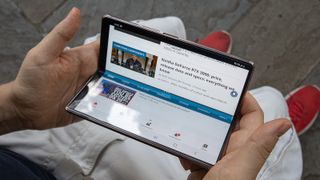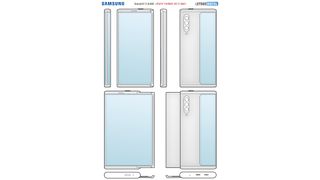Samsung’s next could be a rollable phone with a curved display
Likely to launch next year

Samsung is all set to launch two of its most important mobile devices – Galaxy Fold 3 and the Z Flip 3 along with a couple of wearables like Galaxy Watch 4 and the latest avatar of Galaxy Buds.
The importance of these foldable phones can be assessed by the fact that the company chose to skip its Note line up this year to help foldable phones go mainstream. However, it doesn’t stop the company from planning for the future. And while you wonder – what next after foldable phones? Well, if all goes well, Samsung may launch a rollable phone shortly.
It is not the first time that we’re hearing about Samsung experimenting with a rollable device. We have reported it once and the company later confirmed the same as well. The South Korean tech brand has oddly filed a new patent for a rollable phone in Germany, however, as expected the application could not escape the keen eyes of folks at LetsGoDigital.
- Best foldable phones 2021: the top folding smartphones right now
- Samsung Galaxy Unpacked 2021: Galaxy Z Fold 3, Z Flip 3, Watch 4 and more to expect
A never seen before design
The publication has pointed out that these patent documents are extremely detailed and describe each design aspect of the upcoming device. Also, Samsung hasn’t followed the regular process i.e. filing a patent in South Korea and then following up with the USPTO and WIPO instead a German patent will help the brand get necessary approvals in Europe – one of its key markets, makes one feel that this device is closer to launch.
Talking about the key highlights of this device imagined by Samsung, it could come with an outward rollable display panel that we’ve seen on LG’s Rollable phone and even on the Oppo X 2021. However, once extended, the overall display real estate on this new Galaxy phone would increase by 40-50% approximately.

On the rear panel, the phone is imagined to have a vertically aligned triple camera sensor along with a horizontal curved secondary display. Interestingly Samsung also talks about using an under-display selfie camera on the rollable panel and in case this gets implemented, it will not only be Samsung’s first even under-display camera but the first of its kind on a rollable display.
Since the front camera is listed as a 4-megapixel shooter, the rear cameras can be used to capture selfies and video calls thanks to the massive secondary display. There could be a dedicated button to expand or roll up the display. Alternatively, Samsung has a provision of using the power button to trigger the rollable display.
Get daily insight, inspiration and deals in your inbox
Sign up for breaking news, reviews, opinion, top tech deals, and more.
In terms of interface, Samsung plans to optimize the display automatically once the screen is expanded or retracted. Samsung also plans to use an in-display fingerprint sensor.



Durability could be a concern
While movable parts on a mobile phone aren’t the most convenient, they are also not considered to be the most durable. Though the patent documents suggest that Samsung intends to keep an outer frame to protect the display once it stretches out, it also wants to use a rigid plate to support the extended display.
The space between the rollable display and the phones’ housing could also be tricky if it allows dust particles to slide in and damage internal components as well as the display itself.
Additionally, the presence of a secondary display also makes the phone more vulnerable as it covers a large part of the rear panel. This means when the display is expanded, users will have displays on both sides making it prone to scratches and smudges easily.
Overall, based on the renders the device does look slightly heavy and is expected to be slightly thicker than usual to house all the extra machinery to support the movement, it does look impressive and costly. Only Samsung and time can tell if this concept will see the light of the day, till then we will have to wait.
Jitendra has been working in the Internet Industry for the last 7 years now and has written about a wide range of topics including gadgets, smartphones, reviews, games, software, apps, deep tech, AI, and consumer electronics.